Vandellia is a genus of catfishes native to South America. The species in this genus are the most well-known of the parasitic catfishes also known as candiru, known for their alleged habit of entering the human urethra.

Pseudoplatystoma is a genus of several South American catfish species of family Pimelodidae. The species are known by a number of different common names. They typically inhabit major rivers where they prefer the main channels and tend to stay at maximum depth, but some species can also be seen in lakes, flooded forests, and other freshwater habitats. They have robust bodies, and are important food fish. Recently, their population size has been on the drastic decline due to a variety of factors including overfishing and habitat destruction due to the construction of hydroelectric dams.

The Pimelodidae, commonly known as the long-whiskered catfishes, are a family of catfishes.

The redtail catfish, Phractocephalus hemioliopterus, is a pimelodid (long-whiskered) catfish. In Venezuela, it is known as cajaro, and in Brazil, it is known as pirarara, stemming from the Tupi language words pirá and arara. It is the only extant species of the genus Phractocephalus. This fish is common in the aquarium trade, although its massive adult size makes it unsuitable for all but the largest aquariums. They feed on fish, crustaceans and fallen fruits. They are not evaluated by IUCN.

Acanthicus is a genus of large, South American suckermouth armored catfishes native to the Amazon and Orinoco basins, and possibly in Guyana. The name Acanthicus is derived from the Greek, akanthikos meaning thorny, spiny. Fish of this genus are known as lyre-tail plecos. These species are found in large rivers, primarily in areas with a rocky bottom and a moderate or strong current.
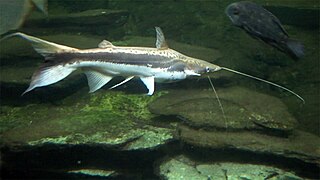
Sorubim is a small genus of long-whiskered catfish native to tropical South America. A number of characteristics allows the differentiation of each species in the genus. Sorubim species are important food fish in South America and are highly significant to fisheries of some areas; however, harvests of these fish are not identified as much as other, more popular food fishes such as Colossoma, Arapaima, and Brachyplatystoma. Some species of this family are popular aquarium fish.
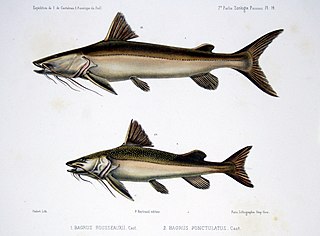
Brachyplatystoma is a genus of catfish from the family Pimelodidae. As the occasionally used common name goliath catfishes indicates, this genus includes some of the largest species of catfish, including the piraíba, B. filamentosum, which reaches up to the region of 3.6 metres (12 ft) in length. Brachyplatystoma are found in the Amazon and Orinoco basins, and other tropical freshwater and brackish habitats in South America. Some species are migratory. These fish are important as food fish and, to some extent, aquarium fish.
Propimelodus is a genus of South American catfish of the family Pimelodidae.

Steindachneridion is a genus of South American pimelodid catfish.
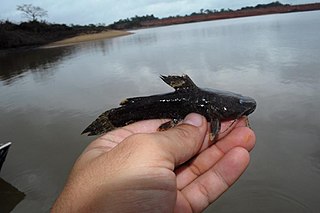
Batrochoglanis is a small genus of catfishes of the family Pseudopimelodidae.
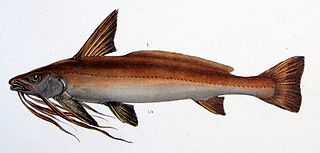
Pinirampus pirinampu is a species of catfish of the family Pimelodidae. P. pirinampu is also known as the flatwhiskered catfish.
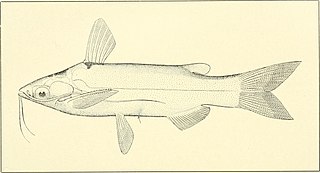
Entomocorus benjamini is a species of driftwood catfish found in the Madeira River system in Bolivia and Brazil. This species grows to a length of 7.0 cm and can be distinguished from it congeners in that the distal half of dorsal caudal fin lobe and the edge of the ventral lobe is pigmented. E. benjamini has been classified as an invertivore that feeds on aquatic and terrestrial invertebrates, zooplankton, and both aquatic and terrestrial vegetation. It has been noted that a single fish could ingest as many as 1700 planktonic crustaceans in a single night, when this species feeds near the water surface.
Brachyplatystoma capapretum, the dark caped goliath catfish, also called Peru piraiba catfish or false piraiba, is a species of catfish of the family Pimelodidae that is native to watershed areas of Brazil and Peru.
Brachyplatystoma filamentosum, the piraíba or kumakuma, is a species of large catfish of the family Pimelodidae and genus Brachyplatystoma that is native to Amazon and Orinoco River basins and rivers in Guianas and northeastern Brazil.

Brachyplatystoma rousseauxii, the gilded catfish or dourada, is a species of catfish of the family Pimelodidae that is native to Amazon and Orinoco River basins and major rivers of French Guiana.
The Highwaterman catfish, is a species of pelagic potamodromous catfish of the family Pimelodidae that is native to Guyana, Suriname, Venezuela, northern Brazil and Gulf of Paria.
The Dolphin Catfish,, is a species of demersal potamodromous catfish of the family Pimelodidae that is native to Santarém and the Negro River basin of Brazil and Venezuela.
Hypophthalmus marginatus, commonly called the Mapará, is a species of demersal potamodromous catfish of the family Pimelodidae that is native to Amazon and Orinoco River basins of Brazil, Peru and major rivers of French Guiana and Suriname.
Hypophthalmus oremaculatus, is a species of demersal catfish of the family Pimelodidae that is native to Paraná River basin of Argentina and Brazil.
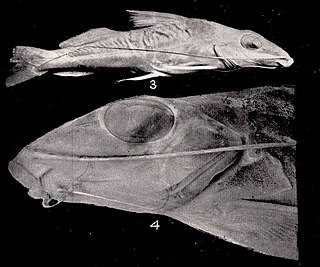
Iheringichthys megalops, is a species of demersal catfish of the family Pimelodidae that is native to Paraná River basin of Paraguay.










